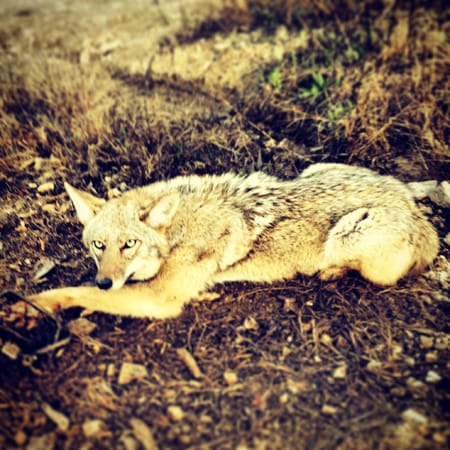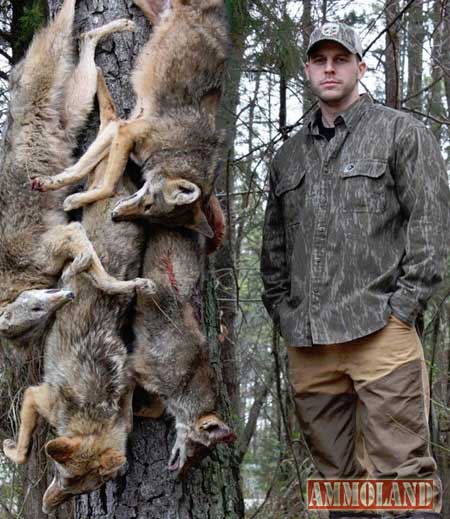
GameKeepers Club
USA –-(Ammoland.com)- You would be hard pressed to find someone who doesn’t agree with this point…Coyotes are plentiful and their numbers are up almost everywhere.
Their boom in population east of the Mississippi in the last 40 years is very impressive.
With everyone seeing more coyotes when they are outdoors, they catch the blame for a lot of issues facing small game, especially whitetail fawn recruitment. Like it or not the song dogs are here to stay. You can kill as many as possible on your piece of property and definitely “help the cause” when it comes to protecting fawns, but there will always be coyotes around.
The argument has been made that you need a few around to keep the other small predators in check and there is some good research that supports this claim. However no one likes the idea of coyotes managing their deer herd for them. While coyotes may not have a major impact on the overall deer population of a given county or state, they can definitely effect small pockets and that might be your property.

Let’s look at a few things that can be done to increase fawn survival rates.
One of the most effective ways to remove coyotes from a property is through an intense trapping program. One thing many people don’t realize is that the fawning season also lines up when many coyote pups are born. Fawns are not only a favorite meal for coyotes, but they are also eating more this time of year in order to feed a litter of pups.
Although trapping seasons vary on a state to state basis, the most effective time to remove coyotes through trapping is immediately before the peak in fawning activity for that piece of property. Removing 70% of coyotes at the peak of fawning season can dramatically increase fawn recruitment rates. Recent studies have shown where recruitment rates were increased 150-215% on land where the majority of coyotes were removed at peak fawning time.
If there ever was a case for buck to doe ratio’s to be kept in check this may be as important as any of them. Land that is managed for 1:1 ratio of buck to does, has a fawn drop that will happen all within about a 2 week period. This means all the fawns hit the ground at almost the same time making it much harder on predators to negatively affect the recruitment rate of that property. When buck to doe ratios are more skewed and are more in the 7:1 range for example, the fawn drop is much more spread out and predators such as coyotes have a much better chance of negatively impacting your overall fawn survival numbers. Coyotes and other predators can also suppress an already low number of deer from rebounding from natural die off or abused doe harvest.
A section of a southern state that I grew up hunting was hit pretty hard about 5 years ago by EHD (epizootic hemoragic disease). Overall population of deer in this area looked to be down 50-70%. This massive hit to the population along with a very liberal doe harvest had numbers as low as the area had probably seen since the 1960’s.
The areas still seems to be struggling to rebound anywhere close to previous numbers, and I believe the low quality fawning habitat, liberal doe harvest rules, and increased number of coyotes is keeping the deer in this area suppressed well below carrying capacity.
Another aspect in increasing fawn recruitment rates is by providing adequate cover and fawn rearing habitat. Fawns need tall, thick, grassy cover ideally to hide in until they reach the age to start following their mother. In a recent southeastern study, 65% of fawns that are taken by predators are killed in their first three weeks of life. Even areas with moderate to high predator populations can have good fawn survival numbers when good fawning cover is present. On the flip side, land that has very poor cover and fawning habitat can be heavily affected by even a moderate to low coyote population. Creating good fawn cover can be as simple as taking a chainsaw and doing a hinge-cut on a section of timber. The result of getting daylight to the ground in an area previously over shadowed by the thick canopy of leaves is a wealth of new native plants and grasses that will not only serve as great bedding cover but also provide some food value to a whitetail. Native warm season grasses are another great way to create a positive environment for fawns and mothers. Unused pastures or low quality timber can be removed with heavy equipment to create 2-5 acre blocks to be planted in grasses such as Switch grass, Indian grass, Big Bluestem, etc. Once established, the grasses are very tall and thick and wind has a hard time penetrating the lower levels where fawns lay. This makes it very difficult on coyotes to be able to systematically hunt down fawns by smell.
The bottom line boils down to this; we will always be dealing with coyotes, they are natural predators and part of God’s plan. Hunting and trapping can certainly have a positive outcome for a short period of time, but you are never going to completely rid yourself of coyotes.
If you manage a piece of property and identify predators as being the primary cause for low fawn recruitment, look at implementing a year round trapping program and create some new fawn-friendly areas that give them a better chance at survival. In the circle of life, predators have their place and I’m certainly glad because they are so enjoyable to hunt, however we as humans being the top of the food chain shouldn’t like the idea that these fanged varmints may be doing the majority of the killing on our tasty table fare.
Would you like to learn more about improving your hunting and get discounts on the products you need? Learn from the experts by joining the new Mossy Oak GameKeepers Club at www.gamekeepersclub.com. Or call 844-256-4645.
